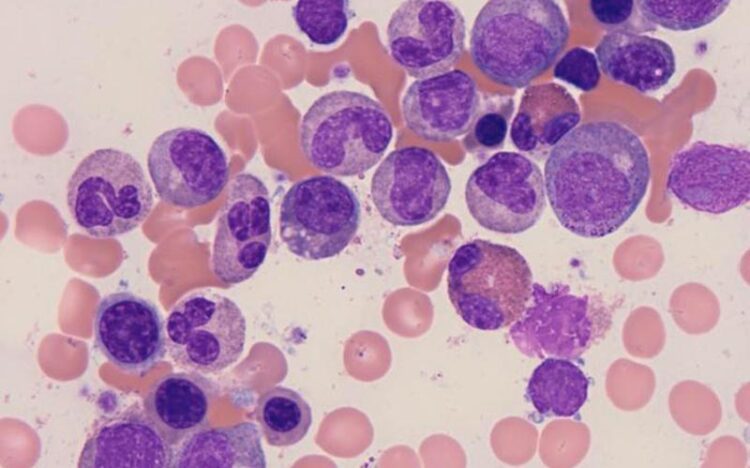Researchers uncover mechanisms behind enigmatic shapes of nuclei

Neutrophils, blood cells that serve as a first-response to invading bacteria, feature nuclei that — rather than being uniformly round as most other cells — are divided into multiple petals or lobes, allowing them to migrate into densely populated tissues. Here they are shown in human bone marrow (purple cells) in the company of many red blood cells.
Credit: Dr. Huan-You Wang
Scientists may be able to direct immune cells toward diseased areas.
Nearly 150 years ago, scientists discovered that specialized blood cells serve a vital role in immune system protection against infection and illness.
Certain groups of these white blood cells, now known as neutrophils, feature a nucleus that is structured strikingly different than most nuclei. The majority of cells feature round- or oval-shaped nuclei that are rigid, but neutrophils differ in that their nuclei adopt multiple lobular structures akin to that of flower petal arrangements.
These unique nuclear shapes permit neutrophils to travel all over the body to identify and combat invading pathogens. While much is now known about the role of neutrophils in combatting infection, how such peculiar nuclear structures are assembled has remained enigmatic since the 1880s.
Reporting in Nature, University of California San Diego School of Biological Sciences Postdoctoral Scholar Indumathi Patta and Professor Cornelis Murre, in collaboration with Dr. Ming Hu at the Cleveland Clinic Foundation, have deciphered the shapeshifting puzzle of the neutrophil nucleus.
“We now know how these nuclear shapes are assembled and it’s a beautiful process,” said Murre, a distinguished professor in the Department of Molecular Biology.
Using a combination of ancient staining procedures combined with advanced techniques, named chromosome-conformation-capture studies, the researchers unveiled how flower-like nuclei are assembled. While chromosomes of rounded cells fold into stacked bundles of DNA loops, neutrophil genomes lack such loops. Remarkably, when the researchers removed chromatin loops, progenitor cells swiftly converted round nuclear shapes into flower petal arrangements like those found in neutrophils. This simple conversion also sufficed to activate thousands of genes associated with an inflammatory gene program that allows neutrophils to combat invading bacteria.
After unveiling the neutrophil loop assembly question, the researchers now believe they have the instructions to guide the development of new nuclear shapes.
“This potentially opens an exciting new chapter in immune therapeutics since theoretically it should be possible to change the nuclear structure of killer immune cells so that they can more easily invade complex, solid environments, such as tumors,” said Murre. “Essentially, this could lead to engineering novel nuclear shapes in effector immune cells, which is a new concept in therapeutics development.”
The authors of the study include: Indumathi Patta, Maryam Zand, Lindsay Lee, Shreya Mishra, Alexandra Bortnick, Hanbin Lu, Arpita Prusty, Sara McArdle, Zbigniew Mikulski, Huan-You Wang, Christine Cheng, Kathleen Fisch, Ming Hu and Cornelis Murre.
Journal: Nature
DOI: 10.1038/s41586-024-07086-9
Method of Research: Experimental study
Subject of Research: Cells
Article Title: Nuclear morphology is shaped by loop extrusion programs
Article Publication Date: 14-Feb-2024
Media Contact
Mario Aguilera
University of California – San Diego
maguilera@ucsd.edu
Office: 858-822-5148
All latest news from the category: Life Sciences and Chemistry
Articles and reports from the Life Sciences and chemistry area deal with applied and basic research into modern biology, chemistry and human medicine.
Valuable information can be found on a range of life sciences fields including bacteriology, biochemistry, bionics, bioinformatics, biophysics, biotechnology, genetics, geobotany, human biology, marine biology, microbiology, molecular biology, cellular biology, zoology, bioinorganic chemistry, microchemistry and environmental chemistry.
Newest articles
Faster, more energy-efficient way to manufacture an industrially important chemical
Zirconium combined with silicon nitride enhances the conversion of propane — present in natural gas — needed to create in-demand plastic, polypropylene. Polypropylene is a common type of plastic found…

Energy planning in Ghana as a role model for the world
Improving the resilience of energy systems in the Global South. What criteria should we use to better plan for resilient energy systems? How do socio-economic, technical and climate change related…

Artificial blood vessels could improve heart bypass outcomes
Artificial blood vessels could improve heart bypass outcomes. 3D-printed blood vessels, which closely mimic the properties of human veins, could transform the treatment of cardiovascular diseases. Strong, flexible, gel-like tubes…




















